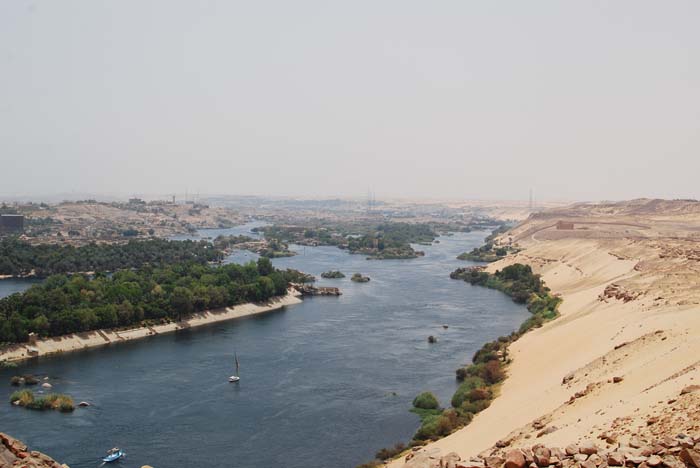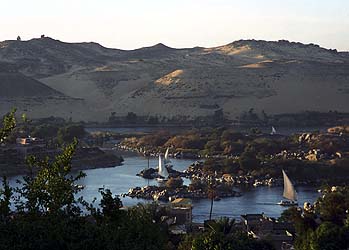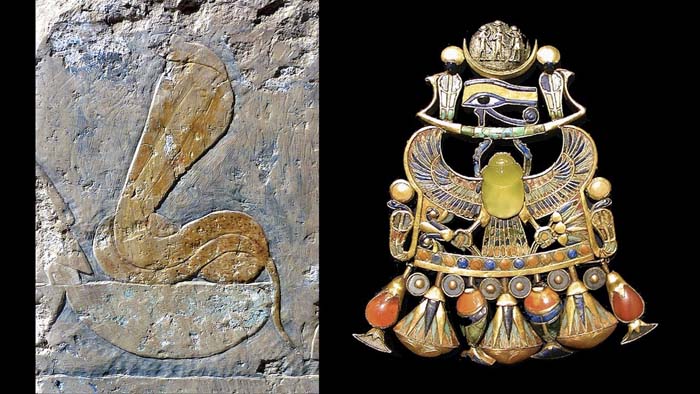The Nile River in Ancient Egypt
The Nile River has certainly played a critical role in the history of ancient Egypt. Famous as the longest river in the world, the river got its name from the Greek word Neilos, which means valley. The Nile floods the lands in Egypt, leaving behind black sediment. That's why the ancient Egyptians named the river Ar, meaning black.
"A land won by the Egyptians and given them by the Nile." -Greek historian Herodotus (circa 500 B.C.)
The story of the Nile River begins not in the lush coastal lagoons of its Mediterranean mouth, nor at its headwaters high in the cloud forests of Rwanda, but in the Western Desert of Egypt.
Here, there is no Nile. There is no water. It is a Martian landscape, inhabitable except for a few scattered oases. It is a Saharan playground for dust storms and locusts, where shovel-snouted lizards dance on two feet to avoid the scorching sands of mid-day.
This is Egypt without the Nile.
Small wonder, then, that the Ancient Egyptians prized and venerated the Nile River. It was their umbilical cord. Even today, a common Egyptian blessing is: "May you always drink from the Nile." From its cooling waters came perch fish bigger than the fisherman. From its loamy riverbanks came mud used for bricks and papyrus for books and boats.
Every year, when the Nile River flooded and saturated the parched land in water and life-giving silt, the Egyptian farmers thanked the god Hapy and began their calendar anew.

©Jiseon Shin - View of the Nile and the desert banks
A Satellite View of the Nile River
Were you to hitchhike a ride on a satellite, you could see the Nile River in its entirety. For almost 4,250 miles the While Nile snakes through nine countries, from the Delta region of Lower Egypt all the way to Lake Victoria, the biggest of the African Great Lakes.
The Blue Nile begins at Lake Tana, Ethiopia, and joins the White Nile south of Egypt in Khartoum, Sudan. Together, they make up the longest river in the world, the blue thread that binds Africa.
When you think of Ancient Egypt, you probably imagine the Great Sphinx and the limestone pyramids of the Giza Plateau. You picture the towering obelisks of Memphis and the ochre domes of Cairo. These cities were the nerve center of Ancient Egypt. They lay just 20 miles South of where the Nile cleaves into the many channels and canals of the fertile Nile Delta.

© NASA - Satellite view of the Nile River
The fan-shaped Delta is flat as a pancake and green as a leprechaun. At its farthest reaches sat the great port city of Alexandria, home to the lighthouse Pharos, one of the Seven Wonders of the Ancient World. Beyond the Nile Delta is nothing but the salt solution of the Mediterranean and past that, Europe.
At the opposite end of Egypt, where the Nile snakes into the country, was the gateway city of the country: Aswan. It was small, hot, a garrison town for the Egyptian armies.
Trade and Transportation on the Nile River
You might be tempted to ignore the stubby structures of frontier Aswan, known in Ancient Egypt as Swenett. You might focus on the more impressive pillars of Cairo and the temples of Giza – but there would be no pyramids and no shrines without little ol' Aswan and the Nile River.

Dhow on the Nile River near Aswan
Aswan is hot. It receives essentially no rain. Ever. Daytime temperatures hover over 100 degrees six months out of twelve. The only source of water is the Nile, less than half a mile in width. But Ancient Egypt considered Aswan indispensable for its special granite, a rock called Syenite.
Rough-hewn blocks were chiseled from raw stone, loaded onto barges, and shipped down the placid Nile River to the halls of the god-king pharaohs. During flood season, this trip would take about two weeks, for there was not a single cataract to delay the trip. During the dry season, the same trip would take about two months. Ships would return bearing cargo and men, their sails fattened by northern trade winds.
The Nile River was Ancient Egypt's highway. There were no semi-trucks, no Amazon Prime 1-day shipping offers. There was only water. No bridges spanned the Nile's girth in ancient times. Only boats could plow the surface and skim across the channel measuring 20-40 feet deep.
Around 4,000 B.C., the Ancient Egyptians first lashed bundles of papyrus stalks together to make rafts. Later, craftsmen learned to build wooden ships using local acacia wood. Some of these boats could carry cargo up to 500 tons. That's as much as 125 elephants! Where boats could no travel over desert sands, Egyptians rode camels from one hidden cistern to another.

© Jerzy Strzelecki - Boats on the Nile
Flora and Fauna of the Riverbanks
Animals
Of course, most Egyptians rarely saw the Nile from its center. The farmer of the Middle Kingdom would have stood at the water's edge and peered across two miles of silvery blue. In the summer, those two miles might expand to five or ten. Torrential spring rains in Ethiopia and sub-Saharan Africa would cause the Egyptian Nile to overflow its banks for 4-6 months, inundating the surrounding flood plain in black silt.
The Nile River plain was a suitable living environment for a variety of animals.
The two largest herbivores are the hippopotamus and black rhinoceroses, both of which are now nearing extinction. Blue herons and white ibis birds scope out the shallow waters for small fish, eels and snakes. The Nile River contains more than 30 species of snakes, and more than half are venomous. Not for nothing did Cleopatra, the great Queen of Egypt, die from the bite of an asp.

© Lucas - Depictions of Snakes, Wadjet Amulet
This annual flooding cycle enticed water-loving amphibians, reptiles and birds to come dwell in the Nile. The most common reptile is the Nile crocodile, a grayish beast that grows up to 1,500 pounds. It waylays unsuspecting gazelles and small mammals who come to feed at the riverbanks.
Nile Crocodile Facts - The Nile Crocodile has been a major component of the Egyptian culture and way of life since the first Egyptians settled along the fertile banks of the Nile. Most Nile Crocodiles are approximately 4 meters in length, although some have been reported as longer.
They make their nests along the banks of the Nile River, where the female may lay up to 60 eggs at one time. Some three months later the babies are born and are taken to the water by their mother. They will remain with her for at least two years before reaching maturity.

© Cloudtall - Nile Crocodiles
Farming and Food
Although Ancient Egyptians relied on fish for animal protein, they obtained most of their food from the earth. The rich topsoil of the Nile basin can measure up to 70 feet deep. It is a farmer's utopia. After Ahket, the season of Inundation, villages planted the first seeds.
During Peret, the growing season, which lasted October-February, farmers tended their fields. Shemu was the season of harvest and abundance. They would either carry water by hand, by camel, or would dig irrigation canals from the Nile River to water the rich black kemet of the fields.
Farmers cultivated all manner of crops: barely for beer, cotton for clothing, melons and pomegranates and figs for an evening meal. But three crops stood out: wheat, flax, and papyrus. Wheat was ground into bread, flax was spun into linen, and papyrus dried into a paper substitute.

© GoShows - Harvest Season
Spirituality and World View
The Nile River, for all its importance to the Ancient Egyptian, had no deity. It didn't even have a name. Most simply called it "the river," or "aur," which means black. The closest thing to a god assigned to the Nile was Hapy, the god of the Inundation. Hapy had no temple. He was a fat, jubilant deity praised at the beginning of every flood cycle and mentioned only in passing the rest of the year.
Yet even though the Nile did not play a central part in Ancient Egyptian spirituality, it was the center of their social world view They oriented themselves in reference to the south, from whence the river came. The east bank, where the sun rose, was the side of birth. The west bank, where the sun set, was the side of death. All Ancient Egyptian tombs and pyramids were constructed on the west side of the Nile.
To Egyptians, flooding was normal; rain was weird. They called the downpours of other cultures "the Inundation in the sky". Their 365-day calendar rose and fell with the waters of the Nile. In fact, a poor man was symbolized as having no boat. And when a Pharaoh was entombed, a small boat or model of a boat would be buried with him so that he might "pass to the other side", that the cold waters of the Nile would bear him, the symbol of Egypt, in death as they had in life.

© KOMUnews - Nile Flooding
River Nile Facts
How long is the Nile River?
- The Nile River is actually 6695 kilometers (4184 miles) long. With such a long length, the Nile River is speculated to be the longest river in the world.
- It winds from Uganda to Ethiopia, flowing through a total of nine countries. While the Nile River is often associated with Egypt, it actually touches Ethiopia, Zaire, Kenya, Uganda, Tanzania, Rwanda, Burundi and Sudan, as well as Egypt.
- It's only recent that the first known navigation team successfully followed the river from beginning to its end.
How did the ancient Egyptians use the Nile River?
- The Nile River has played an extremely important role in the civilization, life and history of the Egyptian nation.
- One of the most well known river Nile facts is the river's ability to produce extremely fertile soil, which made it easy for cities and civilizations to spring up alongside the banks of the Nile.
- The fertile soil is created by the annual spring floods, when the Nile River overflows onto the banks.
- Much of the Egyptian nation consists of dry desert land. Throughout most of the year, very little rain falls on Egyptian deserts. This has remained true for thousands of years. The abundant Nile River provided much needed irrigation, even in ancient times.
- This waterway also provided a source of drinking water, as well as papyrus reeds that could be used for a variety of purposes such as paper and building materials.
- Today, exotic and sophisticated cities like Cairo grace the banks of the Nile River, as they have for thousands of years. Individuals interested in experiencing the Nile up close and personal can journey along the famous river aboard riverboat cruises that depart from numerous cities along the bank.
